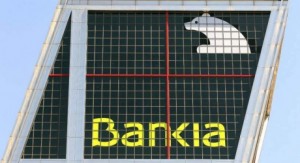
Measured from the close of May 7 – the day Bankia’s president Rodrigo Rato announced his resignation – through noon of Thursday the 18, when its shares hit a low of €1.17, Bankia shed no less than 48 percent of its value. Adding to this the 40 percent lost since the July 2011 initial public offering through early May (this perfectly in line with the average euro zone bank over the period, by the way) and the hoards of retail depositors cajoled into parting with their savings in order to subscribe to the IPO by their local bank managers, we’re looking at just shy of a 70-point loss in a bit over eight months. It wasn’t intended to turn out that way.
When Banco Financiero y de Ahorros (BFA) was formed from the fusion of the very large Caja Madrid, the less bulky but still significant – especially if one considers its advanced state of financial distress – Bancaja and several other regional cajas de ahorros, the original plan was to hive off a retail bank in good enough shape to interest both retail and institutional investors in buying into a share offering. But the negotiations between the cajas as to how to accomplish this dragged on and on, tied up by the trump card held by a very recalcitrant (and probably insolvent but for the moral support of the Bank of Spain) Bancaja, just as investors were bailing out of European banks in general.
The IPO was delayed by the haggling until the summer and Bankia, the retail bank born of all this, was stuck trying to sell itself to nearly null institutional interest. Bankia’s owners initially had thought they would be able to raise €5 billion by selling 20 or 30 percent of the bank at as much as eight euros a share. In the end, they had to resort to the hard sell on its retail banking customers to make it happen. Rato and company were finally forced to part with nearly half at €3.75 and still failed to reach their financial goal. To give an idea how unappealing this investment was, insurance company Mapfre – itself partly owned by Bankia – took up over 4 percent… but through its not-for-profit charity Fundación Mapfre.
The end came because of a dispute between BFA’s (and Bankia’s) auditors, Deloitte, and BFA itself. When the accountants refused to allow the holding company to value its share in Bankia according to its wishes, the parent company became insolvent and had no choice but to ask the Bank of Spain to exercise its right to convert its €4.4-billion life saver loan to BFA to equity.
Run for the exits
The real, long-term damage in all this is to the already drastically reduced credibility of Spain’s banks – and thus to their future ability to raise money through equity offerings. In theory, there should have been no real reason for shares in Bankia, presumably a separate company, to take such a beating. And in fact, it could be easily argued that they were better off with the Bank of Spain, rather than BFA, lording over them. Unfortunately, no one took the trouble to communicate anything to the hundreds of thousands of small investors who were watching their savings go up in smoke.
In an environment of confusing news reports that failed to distinguish between BFA and Bankia and a veritable scandal in which BFA submitted and published its unaudited 2011 results while Bankia delivered theirs to the stock market supervisor CNMV and to the public through the website of the watchdog, in the form of an illegible, corrupted pdf file (in which state they remain), the natural response was to run for the exits – closing their accounts in the process, if recent rumours of large scale withdrawals are true.
It’s going to be a long time before most of the remaining groupings of ex-cajas will be able to turn to the stock market for salvation. Deep pockets will have to be found elsewhere.
Bankia stock is currently trading at about €1.70 on the Madrid stock exchange.
Charles Butler is the publisher of Ibex Salad.
Leave a Reply
You must be logged in to post a comment.